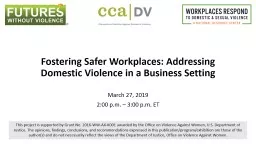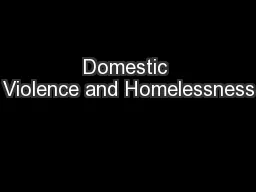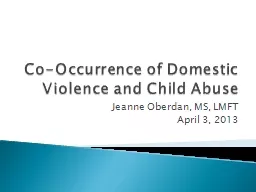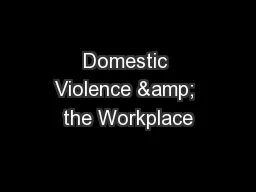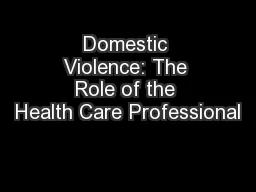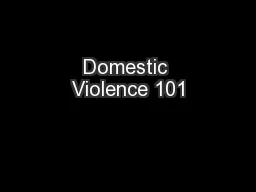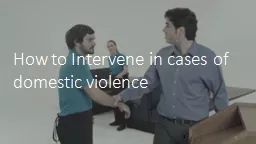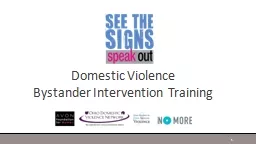PPT-Fostering Safer Workplaces: Addressing Domestic Violence in a Business Setting
Author : tawny-fly | Published Date : 2019-11-05
Fostering Safer Workplaces Addressing Domestic Violence in a Business Setting March 27 2019 200 pm 300 pm ET This project is supported by Grant No 2016WWAXK001
Presentation Embed Code
Download Presentation
Download Presentation The PPT/PDF document "Fostering Safer Workplaces: Addressing D..." is the property of its rightful owner. Permission is granted to download and print the materials on this website for personal, non-commercial use only, and to display it on your personal computer provided you do not modify the materials and that you retain all copyright notices contained in the materials. By downloading content from our website, you accept the terms of this agreement.
Fostering Safer Workplaces: Addressing Domestic Violence in a Business Setting: Transcript
Fostering Safer Workplaces Addressing Domestic Violence in a Business Setting March 27 2019 200 pm 300 pm ET This project is supported by Grant No 2016WWAXK001 awarded by the Office on Violence Against Women US Department of Justice The opinions findings conclusions and recommendations expressed in this publicationprogramexhibition are those of the authors and do not necessarily reflect the views of the Department of Justice Office on Violence Against Women. Overview. 1. Domestic Violence 101. Definition. Dynamics . Statistics . 2. Domestic Violence and Homelessness. 3. A Survivor’s Story. 4. Issues for the Balance of State. Confidentiality . Coordinated Entry. Intimate Partner Sexual Violence (IPSV). &. Stalking. Law Enforcement 2009 Training Guide. This project was supported by Grant No. 2005-WE-AX-0132 awarded by the Office on Violence Against Women, U.S. Department of Justice. The opinions, finding, conclusions, and recommendations expressed in this publication/program/exhibition are those of the author(s) and do not necessarily reflect the views of the Department of Justice, Office on Violence Against Women. By Jami Brookes Berry. Table of Contents. Article 1: What is Domestic Violence? . By U.S. Department of Justice. Article 2: As Domestic V. iolence forces women, children into homelessness, shelters work to help. Hayley Holden. Mission. : . To . engage voices to create change in the prevention, intervention, and response to domestic violence, dating abuse, stalking, and sexual assault. .. Who are they?. Who I Worked With. Jeanne Oberdan, MS, LMFT. April 3, 2013. ALIVE. Mission. ALIVE's mission is to provide counseling, emergency sanctuary and other critical. services to adults and children impacted by domestic abuse, as well as to increase. “Domestic violence doesn’t stay at home when victims go to work” . (MAG DV Council). Today’s Presenter . – . Melody Hicks, MC, LPC. . Behavior Health Integration Manager . . Leo Alonso, D.O.. 16. th. Annual Cardiovascular Symposium. Domestic Violence (DV). All individuals involved in clinical practice have an opportunity to assess and intervene in DV, the largest cause of injury to women in the US.. and. it’s Impact on Young Children. Tyshaunda Wiley. Prevention Coordinator. Presented 12/14/2016 . to the Early Childhood Collaborative of Southington. Our mission is dedicated to helping individuals achieve lives free of domestic violence by providing care, advocacy, support, and education.. 1. 5. Steps to Intervening. 2. The Five Steps to Intervening. 3. STEP 1: NOTICE AN EVENT IS HAPPENING. Actions or patterns of behavior that might signal someone is perpetrating domestic violence. . Someone who seeks to exert power and control through:. Exposure in . Early Childhood. Leah Kinnaird, LMSW. Domestic Violence Liaison to DHS. Iowa State University. Definition of . Domestic Violence. Definition. Domestic violence is a pattern of assaultive and coercive behaviors – including physical, sexual, and psychological attacks as well as economic coercion – that adults or adolescents use against their intimate partners. (DHS Manual – Title 17, Chapter B(3).). on Children. 1. ". How does . exposure to . domestic violence . affect children?". 2. Childhood Exposure to Domestic Violence . Increases the Likelihood of Children Experiencing. Failure to thrive. Bed wetting. Training Objectives. How children are effected by domestic violence. Different ages/stages and how DV impacts a child’s development. Parent/child bond. Why a victim may stay in an abusive relationship. Kristine Paranica, Executive Director, Conflict Resolution Center, University of North Dakota. Certified Transformative Mediator™. Fellow of the Institute for the Study of . Conflict Transformation. 1. About . See the Signs, Speak Out . Free, online-based . . trainings for workplaces. Seethesigns.org. 2. Intro to bystander intervention. – . 10 . min . Understanding Domestic Violence– 25 minutes.
Download Document
Here is the link to download the presentation.
"Fostering Safer Workplaces: Addressing Domestic Violence in a Business Setting"The content belongs to its owner. You may download and print it for personal use, without modification, and keep all copyright notices. By downloading, you agree to these terms.
Related Documents

